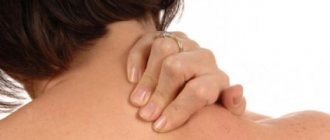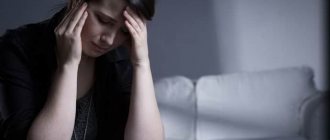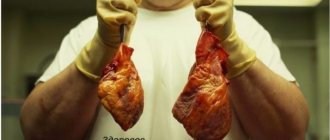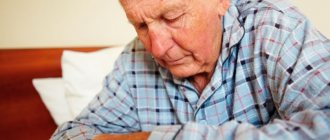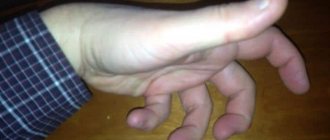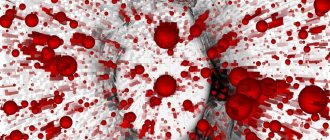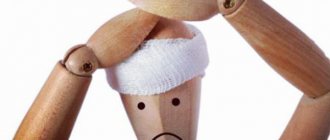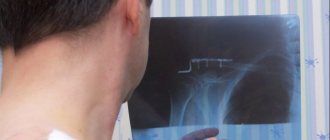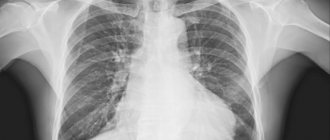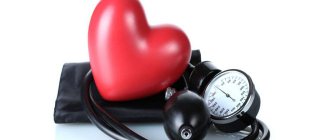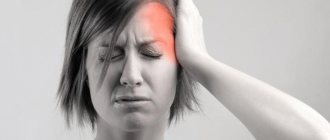Muscle spasms and headache
Approximately 70% of the world's inhabitants periodically complain of headaches.
It can signal the presence of one of at least forty-five diseases or be an independent disease. If you experience headaches quite often, then the painless, unique method of Dr. Bobyr
Cheaper than manual therapy
Get a pass and come visit us!
Only from April 10 to April 20! Sign up!
Approximately 70% of the world's inhabitants periodically complain of headaches. It can signal the presence of one of at least forty-five diseases or be an independent disease. If you experience headaches quite often, in order to
Irritation of pain receptors leads to the fact that a person begins to feel pain in the head. Most of the receptors are located in the tendons and muscles of the scalp, so very often headaches are of muscular origin. As a result, the receptors are irritated.
This headache occurs with prolonged tension in the skeletal muscles of the neck and head due to the incorrect position of these parts of the body. Disturbances in the normal biomechanics of the spine (osteochondrosis, scoliosis, incorrect posture or gait) also predispose to the appearance of muscle tension. Therefore, people who mainly suffer from such headaches are:
- students and schoolchildren who sit for a long time in an uncomfortable position. Since many children, adolescents, and young adults have poor posture and scoliosis, this leads to uneven muscle tension. As a consequence, muscle tightness forms, which causes pain.
- people who work as accountants, programmers, musicians, dentists, drivers, etc. Their neck and shoulder muscles constantly tense.
- patients with pathology of the cervicothoracic spine (subluxation, instability of motion segments, osteochondrosis, functional blocking of joints). In this way, the biomechanical basis for muscle tension is formed.
Muscle spasm provokes a narrowing of arterial vessels, malnutrition and the manifestation of oxygen starvation in the muscles. The muscles are not sufficiently supplied with blood, and due to increased tension, lactic acid accumulates in them. It cannot completely exit through the venous network, because the spasm also disrupts the venous outflow. In this case, the muscles swell and pain occurs.
The tone of the arteries that supply blood to the brain is also impaired. This triggers a throbbing pain. It can occur on a certain side of the head.
When the muscles of the cervical-collar zone are tense, venous congestion is recorded, and prolonged muscle spasm provokes intracranial venous hypertension. This is how morning headaches or complaints about a “stale head” appear.
Source: www.spina.ru
What to do to prevent this from happening again
After the body has recovered, do not forget that unpleasant symptoms may occur again. Incorrect posture during work, a sedentary lifestyle, improper nutrition, various diseases and disorders weaken muscle tissue. As a result, muscle spasms become more frequent.
Simple exercises will help prevent this:
- strengthening the muscles located on the inner thigh (half-squatting with alternating legs);
- strengthening the quadriceps muscle (lunges forward followed by shifting the center of gravity);
- strengthening the calf muscles (small lunges with the foot placed 20cm from the floor).
Compliance with an active regimen, preventive examinations, regular treatment of existing diseases is half the success of good health and functioning of all body systems. And then the hodgepodge of muscle spasms, cramps and headaches will become a rare occurrence for you.
Causes of muscle spasm in the neck
Neck muscle spasms can occur in anyone. The reasons for it may be different. Here are some of them:
- incorrect posture (stooping);
- too much weight on the shoulders (for example, when carrying heavy bags);
- heavy lifting (carrying heavy objects with one or both hands);
- non-physiological postures (holding the handset between your shoulder and ear for a long time, uncomfortable sleeping position, etc.);
- emotional stress (research shows that stress can negatively affect the neck and shoulders);
- physical activity (straining and straining the muscles of the neck and shoulders during exercise or sports);
- excessive stress on neck muscles that are already tense or damaged;
- headache (sometimes headache is accompanied by neck pain);
- dehydration (insufficient fluid intake can lead to neck cramps);
- cervical osteochondrosis (degeneration (wear) of the vertebrae and intervertebral discs of the neck);
- whiplash injury (when the head is thrown back sharply, and then just as sharply tilted forward (usually in a car accident));
- working at a computer (working at a computer for a long time can cause pain, stiffness and spasms in the neck);
- intervertebral hernia or protrusion of the cervical spine (protrusion of part of the internal disc material into the spinal canal through a crack in the outer shell of the disc);
- stenosis (narrowing) of the spinal canal in the cervical spine (for example, due to degenerative changes in the vertebrae);
- congenital problems (some babies are born with torticollis, which means the fetus's neck was in an unnatural position in the womb);
- meningitis (a serious and dangerous infection that causes swelling of the brain and spinal cord);
- Temporomandibular syndrome (affects the jaw and nearby muscles);
- trauma (various accidents, for example, falling).
Prevention
It is almost impossible to avoid osteochondrosis, but everyone is able to delay the timing of its appearance and slow down the development of pathological changes in intervertebral joints and discs. Prevention does not require special knowledge or skills and is available to everyone.
According to experts, preventive measures should be directed against the following causes of the disease :
- Sedentary lifestyle.
- Excess weight.
- Poor posture.
- Spinal injuries.
- Chronic infections in the respiratory tract.
- Constantly working in a position with your head down.
A measure to prevent cervical osteochondrosis is:
- Combating a sedentary lifestyle.
- Weight stabilization.
- Keeping the body in the correct physiological position and undergoing timely preventive examinations by an orthopedist.
- Proper lifting and carrying of heavy objects.
- Elimination of foci of chronic infection.
- Change your position while working every 20-30 minutes. It is recommended to spend this time kneading the muscles of the neck and shoulder girdle. To do this, you need to turn and tilt your head, lightly massage your neck, and rotate your shoulders.
Your health is maintaining a healthy lifestyle. Eight hours of sleep in the right position, long walks in the fresh air, healthy eating, morning exercises and an active lifestyle will help you prevent not only osteochondrosis, but also other diseases. If pain or discomfort occurs, you need to seek help from specialists. Self-medication sometimes leads to deterioration of health.
Symptoms accompanying neck spasm
Pain and other symptoms accompanying neck spasms may vary in manifestation and severity depending on the cause that caused them. However, there are a number of typical symptoms of muscle spasms in the neck.
A spasm itself is a sharp, strong and involuntary contraction of a muscle. Other common symptoms include:
- muscle pain (the muscles in and around the affected area may be inflamed and have nodules that cause pain when touched);
- stiffness (neck muscles can be very tense, leading to difficulty moving the neck);
- pain caused by a pinched nerve (neck pain can radiate to the shoulder, arm, hand, and fingers). Sometimes symptoms such as numbness and weakness in the arm may occur. Pain caused by nerve compression is usually worse at night;
- headache, which is usually felt in the back of the head, but can also spread to the temples and forehead;
- decreased neck mobility;
- “jamming” of the joint in one position;
- fluid accumulation (exertion leads to fluid accumulation, which causes painful muscle nodules to appear).
Features of pain in the occipital region
One-time cases of pain in the occipital part of the head may not be a cause for serious concern, but if the nature of the pain syndrome is severe, aches and dizziness are observed, then hospitalization may be necessary. The difficulty of making a correct diagnosis is due to the fact that pain in the occipital region can occur periodically. To choose a treatment regimen, the doctor needs to know where the pain appears: in the head itself or in the cervical region. An unpleasant feature of discomfort: pain can move from one area of the back of the head to another.
On the right side
A headache in the back of the head, which is localized only on one side, may be a symptom of a disease of the brain, upper spine, or nerve roots. The appearance of painful discomfort on the right side in the back of the head is not a reason to suspect a serious problem, because even a simple draft can cause it. The situation should not be allowed to reach a critical state if there is a throbbing headache that recurs periodically along with a feeling of numbness in the back.
Such a case requires mandatory examination, and one of the possible diagnoses is osteochondrosis of the cervical vertebrae, for the treatment of which complex therapy is used. People with cerebrovascular accidents may complain of throbbing pain on the right side of the back of the head, and the likely development of the pathology is a stroke. Just changing your lifestyle or taking a pill will not eliminate the cause; the headache on the right side will become more and more intense, and the feeling of heaviness at the back will become unbearable.
From the left side
Localization of pain in the back of the head can be a sign of neuralgia. Pain syndrome is the body’s reaction to a pinched large nerve in this area of the skull, with unpleasant pulsation on the left being less common than in the back of the head on the right. Frequent causes of the development of this pathology are previous injuries. On the left side of the back of the head, a migraine can cause pain: from the temple, a dull pain spreads to the back of the head.
Pain in the back of the head at the base of the skull
Discomfortable sensations that are constant often indicate the presence of cervical osteochondrosis. The cause of pain in the back of the head is considered to be a sedentary lifestyle and a long stay in an uncomfortable position, which over time leads to limited mobility at the base of the skull. If treatment for this disease is not started in a timely manner, its development will lead to disc protrusion and the formation of an intervertebral hernia, which will severely limit mobility.
Treatment
There are a wide variety of treatments for neck spasms. It is important to choose the right treatment program that is right for you. Sometimes this takes time, which can be frustrating, but you should not give up treatment because this may lead to problems in the future.
Common treatments for neck spasms include:
Peace
Bed rest may be effective in the first few days after symptoms begin. This will allow the neck muscles to rest and partially recover;
Medical massage
Massage increases blood flow to the neck muscles, helping to relieve tension and relieve pain and spasms. Many massage therapists use a heating pad during the procedure or advise their patients to take hot baths to reduce muscle stiffness;
Cold therapy
Applying an ice pack to the neck can help control attacks of pain because the blood vessels dilate after contracting, resulting in increased blood flow to the affected area;
Taking painkillers
Some pain relievers, such as ibuprofen and naproxen, can be effective in controlling pain and also reduce muscle inflammation and swelling;
taking muscle relaxants
When severe discomfort occurs, muscle relaxants help relax the muscles. Such drugs, like any medications, should be used only under the supervision of a physician;
Use of ointments and balms
There are special ointments and balms that help cope with muscle spasms. They often contain menthol, which raises body temperature and soothes muscles;
Non-load traction of the spine
Non-stress spinal traction is effectively used to treat problems in the cervical spine, such as osteochondrosis and intervertebral hernia, spondylosis and spondyloarthrosis.
Therapeutic gymnastics
Gently and gently stretching the neck muscles is usually very helpful in relieving muscle spasms. When muscle spasm is relieved, you can move on to strengthening exercises;
Formation of correct posture
It is important to learn to monitor your posture and constantly correct it, which will help reduce neck pain;
Using Herbs
There are a number of herbs (eg, licorice, catnip, chamomile, horseradish, valerian) that soothe tense and painful neck muscles. Many of these plants have good anti-inflammatory qualities. Adding herbal oils to a warm bath can help relax muscles and avoid spasms and pain;
Compliance with drinking regime
It is important to drink plenty of water, especially if your doctor thinks that neck muscle spasms may be due to a lack of fluid in the body;
Taking strong painkillers
Strong painkillers are used only when a person experiences very severe pain that cannot be relieved by other means. It's important to know that powerful painkillers can easily become addictive and cause a range of unpleasant (and sometimes dangerous) side effects.
In rare cases, surgery may be considered for neck spasms. This occurs when pain and cramping persists for a long time and is the result of certain conditions or diseases. It is also necessary to know that neck surgery carries great risks, including damage to the spinal cord and, as a result, paresis or paralysis.
If a person has experienced neck spasms, this does not always mean that they need professional help. For some people, attacks are mild and occur very rarely. However, if cramps and pain in the neck occur constantly, you should definitely consult a doctor. If this is not done, the problems will worsen and become chronic. Chronic neck pain and spasms are difficult to treat and can have a negative impact on the patient's daily life and ability to work.
The article was added to Yandex Webmaster 2018-06-21, 11:38.
Source: www.spinabezboli.ru
How does muscle spasm manifest in osteochondrosis?
Complications of osteochondrosis are headache and syndrome of the inferior oblique muscle of the head.
Back pain can have different etiological origins. The most common disease accompanied by chronic or acute back pain, discomfort, and fatigue in the paravertebral muscles is spinal osteochondrosis.
Gradual degenerative-dystrophic changes in the spine, characteristic of osteochondrosis, cause pain in the cervical region, back, lower back, as well as in various parts of the head, limbs and internal organs.
The muscular corset in which the spine is located protects it and ensures metabolism. Normally, substances formed during muscle work, including lactic acid, are removed through the bloodstream. Excess lactic acid, when blood circulation is impaired due to spasm, acts on the nerve endings and is felt as pain.
With osteochondrosis, the first protective barrier against further damage to the vertebrae and discs is a spasm of the muscles surrounding the spine. It immediately limits mobility in a disadvantaged segment.
The main manifestation of muscle spasm in cervical, lumbosacral or thoracic osteochondrosis is pain near the site of pathological changes in the spine.
In the Russian language, there are many verbs to describe this condition with osteochondrosis: twisted, jammed, twisted, pinched, shot, etc. They all reflect the forced posture, surprise and extreme discomfort of this condition.
Muscle spasms in cervical osteochondrosis are manifested not only by pain on the injured side, but also by the inability to turn or tilt the head, numbness of the hands, brain symptoms, swallowing disorders, a feeling of a lump in the throat and many other signs. This depends on the location of the pathology in the cervical spine.
Unlike cervical osteochondrosis, thoracic osteochondrosis can be more difficult to diagnose. It occurs less frequently, but imitates the symptoms of other, including emergency, diseases of the chest, kidneys, and gastrointestinal tract.
Osteochondrosis of the lumbosacral region is familiar to almost all adults, as is cervical osteochondrosis.
The spasm of the lower back muscles can be so strong that it puts a person to bed for several days and deprives him of independence. It must be removed with the help of medications and other means.
The pain experienced in osteochondrosis in the spine is in most cases understandable and familiar. Its origin can be easily explained; the treatment methods are familiar not only to doctors, but also to the patient himself.
But rare types of contractions can be difficult to diagnose, and in order to understand their cause, a mandatory examination will be required.
Due to a disturbance in innervation, spasm can occur not only in the muscles surrounding the spine, but also in the muscles of organs, for example, the esophagus, stomach, and intestines. If taking antispasmodics for cervical osteochondrosis helps eliminate contractions, this is good, but you should not take analgesics on your own. Abdominal pain is always a dangerous symptom and therefore requires seeking medical help.
It may seem that relieving the spasm will not particularly affect the disease itself, which is a degenerative-dystrophic process in the spine, but will only temporarily improve well-being. But that's not true.
Muscle spasm not only protects the spinal segment from further trauma, but also creates a vicious circle of metabolic disorders. Compression of the vessels that bring and carry away blood interferes with the flow of normal metabolic processes, the removal of waste, the nutrition of the tissues surrounding the spine and leads to the progression of degenerative changes in it.
Relieving muscle spasm and accompanying swelling and inflammation involves the use of medications such as:
- antispasmodics;
- muscle relaxants;
- non-steroidal anti-inflammatory drugs (NSAIDs);
- diuretics;
- B vitamins.
Massage, reflexology, acupuncture and physiotherapy are successfully used for exacerbations and improve metabolic and regenerative processes in the spine.
Using an ice compress brings relief and reduces swelling in the muscles in the first three days after an exacerbation occurs. In the future, thermal procedures are used.
Contraction of the muscles of the head and neck due to mental stress is also the cause of cervical osteochondrosis, and not only its consequence. Therefore, massage of the cervical-collar area and the use of psychotherapy methods are very relaxing and relieve headaches.
But the main way to treat the symptoms of cervical, thoracic, lumbosacral osteochondrosis is to build a powerful muscle corset of the back and neck. Immediately after the condition improves after an exacerbation, it is necessary to begin traction exercises, improve flexibility and strengthen the back muscles.
Only this will create conditions for normal nutrition and metabolism in the spine, which means it will preserve and even be able to restore its youth and health.
Spasm of blood vessels in the head: causes, how to relieve and treat?
© Author: Marina Klimova, edited by first category doctor Z. Nelli Vladimirovna, especially for SosudInfo.ru (about the authors)
Vasospasm is a condition in which the lumen between the walls of blood vessels narrows. This occurs when the vascular walls contract intensely and for a long time. Spasm of cerebral vessels leads to disruption of blood flow and is characterized by the following symptoms:
- Headache;
- Dizziness with spots in the eyes;
- Tinnitus that worsens with physical activity;
- Nausea, vomiting;
- Impaired speech and spatial coordination, memory loss (in severe cases).
Headaches can be felt anywhere on the head. It can be triggered by stress or changes in weather. In the latter case, this occurs especially often in weather-dependent people. If you measure your blood pressure at this moment, you will find that it is high or low.
Previously, symptoms of cerebral vasospasm were observed mainly in older people, since the elasticity of blood vessels decreases with age. But lately this often happens to young people, especially in large cities. The reason for this situation is the general deterioration of the environment, when there are large amounts of toxic substances in the air and the amount of oxygen is decreasing. Getting into the lungs, and then into the brain, these substances cause a narrowing of its blood vessels, which, coupled with a lack of oxygen, manifests itself in painful and unpleasant sensations in the head.
Causes of the problem
The causes of cerebral vasospasm include the following:
- Overwork. When a person works too much while sitting at a computer, for example, the blood supply to the brain deteriorates and vasospasm occurs.
- Lack of sleep. The brain, like any other organ of the body, needs to rest. His fatigue due to lack of sleep is expressed, among other symptoms such as headache, also in the onset of vasospasm.
- Lack of oxygen. The nutrition of the brain deteriorates, to which the blood vessels react first. You need to spend more time in the fresh air and ventilate the room in which you spend most of your time.
- Smoking. In a person who smokes more than a pack of cigarettes per day, the likelihood of vascular spasms in the head increases many times over compared to a non-smoker.
- Various diseases and conditions:
- Vegetative-vascular dystonia (accompanied by noise and ringing in the ears, shortness of breath, a feeling of weakness in the heart, coldness in the extremities);
- Cardiac dysfunction (shortness of breath, tachycardia):
- Disorders of the thyroid gland;
- Renal dysfunction;
- A brain tumor;
- Osteochondrosis of the cervical spine (narrowing of the openings in the processes of the vertebrae through which arteries pass that supply blood to the brain).
Causes
According to medical experts, spasm of the head muscles, which leads to headaches, can be caused by reasons such as:
- Fatigue of the head muscles, which is caused by prolonged stay in certain forced positions (working at a computer, driving a car, working with small objects on a conveyor belt, etc.).
- Stress, anxiety and depression. In such cases, patients complain not only of headaches, but also of various psycho-emotional disorders (anxiety, irritability, lack of appetite, poor sleep, decreased physical and mental performance).
If you experience a headache caused by spasm of the head muscles, medical specialists recommend holding off on taking painkillers. Very often, a hot shower, walks in the fresh air, massage of the temporal, frontal and occipital muscles, as well as a warm bath, help eliminate spasms of the above muscles. As for massage, it is quite simple. Almost every patient can perform it independently.
If the above measures do not bring relief, doctors in these cases advise patients to take one or two tablets of one of the analgesics. If headache attacks are repeated more and more often, then in such situations qualified medical assistance is already necessary.
When using materials from the site, the active reference is obligatory.
The information presented on our website should not be used for self-diagnosis and treatment and cannot serve as a substitute for consultation with a doctor. We warn you about the presence of contraindications. Specialist consultation is required.
The following risk factors may lead to muscle spasms in the neck:
- Mechanical damage;
- Sedentary lifestyle, “sedentary” professions”;
- Stressful mental states;
- Nerve clamps after sudden movements;
- Avitaminosis;
- Hypothermia and drafts;
- Calcium deficiency.
The neck muscles suddenly tighten, distorting nerve tissue and blood vessels. As a result, pain symptoms appear with spasm of the neck muscles.
Neuroses
Spasms in the neck against a background of mental stress manifest themselves as unconscious muscle contractions, causing sharp pain. This tension can be chronic or temporary. It appears very suddenly. Sometimes - as a result of sudden movements. They create unusually strong pressure for the cervical spine. As a result, blood circulation is disrupted, and the neck muscles begin to contract and ache.
To cope with spasms in case of neurosis, you need to completely relax. Eliminate the source of stress. You can try meditation techniques. Create comfortable conditions for yourself, take your mind off all problems.
Osteochondrosis
Osteochondrosis occurs very often because a huge part of the world's population now leads a sedentary lifestyle. People sit a lot at the computer, incorrectly distributing the load on the neck and the muscles that support it. Symptoms of cervical osteochondrosis are pain, stiffness of movement, numbness. There are “goosebumps” running down your neck and a slight tingling sensation in the back of your head.
To relieve spasms in osteochondrosis, you need to improve blood circulation. Massage and simple physical therapy exercises will help. Unfortunately, taking non-steroidal anti-inflammatory drugs will not help much here. It is better to use vascular drugs - Cinnarizine, Trental.
If the spasm occurs deep in the muscles, compression of the cervical artery may become a complication. As a result, the brain will no longer receive enough oxygen. Exercising in the morning, a contrast shower, and light self-massage will help here. To soothe tense muscles, menthol gels are used.
If the neck and shoulder muscles are spasmed, the pain syndrome can be either aching or shooting. Such tension can become a symptom of mechanical sprains and excessive loads. Here it is better to forget about therapeutic exercises and ensure peace of mind. Non-steroidal anti-inflammatory drugs (Diclofenac, Ibuprofen) will help. If possible, it is better to visit the clinic and get NSAID injections. When used externally, such drugs have the least impact.
Trapezius spasms
If the trapezius is spasmed, the metabolic processes of the head, neck and facial muscles are disrupted. Long-term spasms of the trapezius can lead to cervical osteochondrosis. The muscles of the shoulder girdle will become rough, and if you try to stretch them, pain will occur. Symptoms can be relieved by taking a hot bath or attending massage sessions. Warming pharmaceutical ointments or folk rubs will also help.
If you suddenly turn your head or lift something heavy and overexert yourself, a spasm may appear. At such moments, your head may immediately begin to hurt. Sometimes headaches only appear after a couple of days. When the neck muscles contract, the pain radiates to other parts of the body, depending on the area of innervation of the affected nerves. This can literally lead to the inability to turn your head.
A possible complication in advanced cases is neck myositis. Spasms begin to constrain the muscles of the throat, and the cervical spine becomes distorted. If the problem is not treated, the process can lead to a herniated disc in the neck. Myositis can occur due to hypothermia or draft.
Convulsive contractions of the facial and neck muscles are tonic and clonic. Tonic is a common muscle spasm. It will appear due to excess voltage and low temperature. Clonic seizures are unconscious muscle twitches that can occur due to brain injury, epilepsy, or infections.
To relieve spasm of the neck muscles, treatment should be carried out taking into account the cause of such manifestations. If the problem is not a neurological disease, excess tension in muscle tissue can be removed by simply rotating your head alternately in different directions. Physiotherapeutic procedures are good for relieving muscle tension. Electrophoresis, magnetic fields, laser, low-frequency current treatment.
Massage procedures (including self-massage), acupuncture and the services of a good chiropractor will effectively relieve tension.
The weaker the neck muscles, the worse a sudden, unusual load will affect them. Neck spasm occurs as a result of violation of preventive recommendations and healthy lifestyle rules:
- To prevent your muscles from experiencing excessive tension at night, use a low, medium-hard pillow. Its height should not be more than ten centimeters. It is better to choose a rectangular shape. Ideally, you should sleep on an orthopedic pillow;
- If it happens that you need to stay in one position for a long time and especially sit, warm up your muscles with self-massage techniques. Get up and walk a little during moments of rest. To prevent spasms, rotate your head. This will improve blood circulation, strengthen the muscles that support the head;
- Pay attention to the vitamin-mineral complex, especially during seasonal vitamin deficiency. B vitamins and calcium will help keep the musculoskeletal system in good shape and prevent the development of tension and inflammatory processes;
- Do not stay in the cold for a long time, do not allow drafts. The result can be inflammation and severe muscle cramps.
Neck muscle spasm is a fairly widespread problem due to the large number of muscle fibers in the cervical spine and their relatively high mobility.
This pathology manifests itself in the form of pain in the back of the head and neck, which has its own provoking factors; the pain may radiate to the shoulder and arms. Sometimes numbness, muscle weakness, and paresthesia of the upper extremities occur.
It is possible to palpate pain points and areas of local muscle tension during a neurological examination, identify limitations in motor activity, changes in muscle tone and strength.
Tests carried out in laboratory conditions, as a rule, do not have diagnostic value, unless we are talking about infectious diseases caused by an imbalance of electrolyte balance or the balance of microelements.
Doctors still have not figured out the cause of muscle spasms of the cervical spine, but, nevertheless, factors that contribute to this have been identified. These include:
- traumatic injuries in which the muscle reacts with spasm to pain;
- long-term, static impact on muscle tissue, for example as a result of working at a computer;
- the impact of stress on the psyche;
- pinched nerves resulting from unsuccessful movements, the so-called lumbago;
- lack of magnesium and calcium in the body.
Prevention of muscle spasms and their subsequent treatment begin with determining the cause of the disorder.
Neck muscle spasms due to nerves are involuntary contractions of one muscle or group of muscles, accompanied by acute aching pain. Muscle spasms can be permanent or temporary, appear suddenly and stop just as suddenly. Muscle spasms in the neck can occur due to excessively sudden movements that provoke high pressure in the cervical spine, which leads to poor circulation and causes spasm of the neck muscles and severe pain in the cervical spine.
A wonderful way to relieve nervous stress is meditation and auto-training. Such maximum complete relaxation, carried out in a comfortable position in complete silence, helps restore the body and will help, with ten to twenty sessions of fifteen minutes each, calm the nervous system and feel incomparably better.
Osteochondrosis is the most common disease, which is accompanied by chronic pain in the back muscles, discomfort, and a state of muscle fatigue. Cervical osteochondrosis can have various neurological manifestations in the form of headache, loss of muscle sensitivity, paresthesia of the occipital region and under it.
- There may be strong or small twitchings on either side of the neck area, or they may not be felt at all, just heaviness and stiffness.
- Movements are limited: turning or tilting the head.
- Localization in the hands, swelling of the hands in the morning.
- Difficulty taking deep breaths. A lump may form in the throat.
- A spasmed muscle is hard and painful.
Diagnostics
- Keep your body in good shape. To avoid spasms and muscle tension, you need to give your body regular physical activity. This could be swimming, yoga, Pilates.
- Watch your comfort. Do not sit in one body position for a long time, change positions. Do a light workout after sleep, during breaks at work.
- Dress appropriately for the weather, avoid drafts and hypothermia.
- Make yourself a complete diet, make sure that there is enough of all substances in the body, take vitamin and mineral complexes.
- Consult a doctor in a timely manner if you notice any unpleasant symptoms, and conscientiously and efficiently follow all the doctor’s recommendations.
- Headaches and dizziness;
- Increased fatigue and decreased performance;
- Flashing “flies”;
- Tinnitus that worsens with physical activity;
- Nausea and even vomiting.
- Speech impairment;
- Memory losses;
- Impaired coordination of movements;
- Loss of orientation;
- Fainting.
Eye spasms
The eyes are also part of the brain. Spasm of the blood vessels of the eye, in particular in the retina, can cause visual impairment. For example, periods of blurred vision occur that last from a few minutes to an hour. If the spasm is prolonged, necrosis of the retina may occur, leading to complete blindness. Most often this happens in hypertensive patients or people suffering from frequent headaches. The cause may also be nervous overstrain, sleep disturbances, poor lighting in the workplace, or prolonged sitting in front of the TV.
Narrowing of the fundus vessels can occur during exacerbation of vegetative-vascular dystonia. In this case, the ophthalmologist will diagnose “angiospasm”. If vasospasm is caused by atherosclerotic changes, sclerosis of the retinal arteries is detected in the fundus during ophthalmoscopy. When diagnosed with retinal angiopathy, a person may experience blood pulsation in the vessels of the fundus.
Pressing pain in the back of the head, causes
Causes of pressing pain in the back of the head
The most common causes of pressing pain in the back of the head are cervical osteochondrosis, cervical spondylosis or intracranial pressure.
Cervical osteochondrosis
Cervical osteochondrosis
- This disorder is provoked by the destruction of intervertebral discs. As a result, a person experiences constant pressing headaches in the back of the head, temples and neck. Often such pain is also accompanied by dizziness, nausea, loss of orientation and hearing loss.
- Cervical osteochondrosis is sometimes accompanied by double vision and fog in the eyes. A person suffering from cervical osteochondrosis, throwing his head back, may fall and be immobilized for some time. At the same time he will be fully conscious
Cervical spondylosis
Cervical spondylosis
- This disease is caused by ossification of the connective ligaments of the spine. Bone growths block normal turns and movements of the neck, which provokes constant pain in the neck and back of the head, especially aggravated by turning the head.
- Sudden movements of the neck cause increased pain, and after they are completed, a regular pressing dull pain remains
- Another clear sign of cervical spondylosis is sleep disturbance or its complete absence.
Intracranial pressure
Intracranial pressure
- Intracranial pressure is provoked by an increase or lack of cerebrospinal fluid, cerebral edema, the appearance of a tumor, or an increase in the concentration of blood in the vessels of the brain
- This disease is accompanied by pressing or bursting pain in the back of the head, temples, forehead during sleep, and aggravated upon waking up.
- Pain in the occipital part of the head may be pulsating in nature, and may also be accompanied by nausea, vomiting and lightheadedness.
Treatment of brain spasms
Cerebral vasospasm is a very serious condition. It must be treated by all possible means in order to avoid a stroke, the consequences of which are long and difficult to overcome. Treatment of cerebral vasospasm begins with an accurate diagnosis. To do this, the doctor will prescribe a collection of general tests, as well as an ultrasound of the brachiocephalic arteries (BCA) using Doppler and a magnetic resonance examination of the cervical spine. The size of the lumens in the vessels and the strength of blood flow are determined using angiography, i.e. X-ray of blood vessels with contrast agent.
Based on the results of tests and studies, the doctor prescribes appropriate treatment. If the causes of cerebral vasospasm are due to any disease, then it is the disease that is treated first. After all, Hippocrates said: “Eliminate the cause and the disease will go away.” The doctor will prescribe medications aimed at treating the underlying disease, as well as tablets to treat spasms:
Home Recipes
You can relieve spasm of blood vessels in the head at home with the help of antispasmodic medications or folk remedies.
- A decoction of herbal mixture (valerian, motherwort, anise, yarrow), a decoction of periwinkle, agrimony, and rosehip gives a good effect. Decoctions should be taken when a spasm occurs and drunk throughout the day like tea.
- A compress made from an ice-cold infusion of plantain herbs, dandelion root and St. John's wort quickly relieves spasms.
- A decoction of garlic and thyme leaves. Should be taken before meals. Drink as a course for two months.
Self-massage
At home, you can do a massage by rubbing your temples, forehead, and occipital area.
Aromatherapy
The use of various essential oils can also eliminate vascular spasms. Thus, it is possible to use lavender and jasmine oils, which have a calming effect.
Prevention of painful vasoconstriction
St. John's wort, rose hips, birch, and hawthorn help strengthen brain vessels. Drink a decoction of these herbs instead of tea in courses of two weeks several times a year. Nettle can also be included in the preparations, but in small quantities, since it thickens the blood, thus promoting the formation of blood clots.
– Eliminate fried and fatty foods, coffee, cocoa, chocolate, black tea, cheese, mayonnaise, fatty sour cream, sausages and smoked meats from your diet. Remove the skin from the chicken carcass before cooking. Limit butter and sugar. Completely give up alcohol and tobacco.
+ Add foods rich in magnesium, calcium and potassium to your diet. These are any fresh fruits, especially green apples, prunes, raisins, dried apricots, legumes, and herbs. Also, get into the habit of eating fish frequently—at least twice a week. Drink at least one and a half liters of water per day.
Pumpkin, seaweed, as well as beets (boiled), carrots and cabbage are very useful for blood vessels. From these vegetables, taken individually or together, you can prepare delicious salads by adding onions or garlic. Only you need to dress salads not with mayonnaise, but with vegetable oil with the addition of a pinch of sugar, salt and a few drops of vinegar or lemon juice (mix all ingredients of the dressing thoroughly). Try it, you won't regret it!
To maintain the elasticity of blood vessels, the following recipe is useful:
Mix honey, lemon juice and garlic (0.5 kg of honey, 5 lemons, 5 heads of garlic, finely grated). Place the mixture in a jar, close tightly and refrigerate for a week. Then take 2 tbsp daily for a month. spoons. It can be taken in two doses - morning and evening.
Warning: This recipe is not recommended for people suffering from gastrointestinal diseases. It is better for them to simply eat a few teaspoons of honey every day or add it to tea (only warm, since hot tea destroys all the beneficial properties of honey).
Temper the vessels with contrasting douses. They maintain the elasticity of blood vessels and have a positive effect on the state of the nervous system, disorders of which are one of the causes of headaches and cerebral vascular spasms.
Causes of muscle spasms
There are several factors that can cause contraction and tension in muscle tissue:
- prolonged monotonous workload, a person spends a long time at the computer or remains in one position;
- diseases of the cervical vertebrae;
- physical damage that provokes a reaction to pain;
- frequent stressful situations;
- moral exhaustion;
- intense physical activity;
- the process of bearing a child provokes muscle spasms;
- epilepsy attacks;
- sudden change in temperature;
- diseases that cause insufficient concentration of vitamins;
- inflammatory processes of the spine;
- disturbances in the functioning of the circulatory system;
- back diseases;
- neoplasms of a benign or malignant nature in the spinal cord;
- diseases of the cardiovascular system;
- changes in hormonal levels;
- Alzheimer's disease;
- alcohol abuse, drug use;
- impaired macronutrient levels due to improper use of sports drinks;
- reduced concentration of intracellular fluid, developing with a lack of calcium;
- incorrectly formulated diet with a lack of carbohydrates.
Types of Muscle Spasms
Sudden muscle tension can cause limited movement. Painful sensations develop, which is explained by compression of the nerve processes. The spasmodic state of a person is provoked by sudden rotations of the head and other movements. More often occurs during emotional shock. The following types of muscle spasms are distinguished:
Clonic muscle spasms
The cause of this type of spasm is considered to be stimulation of the cerebral cortex, which leads to synchronous muscle contractions and the development of pain. During a cramp, muscle tissue is relaxed and irregular. During clonic spasms, a person may lose consciousness. Emptying of the intestinal tract and bladder is provoked. After convulsions, disorientation, impaired thinking, and clouded consciousness are possible. The spasm occurs suddenly.
Tonic muscle spasms
The occurrence of tonic contractions is explained by overexcitation of areas of the brain under the cortex. Cramps vary in intensity. The main characteristic feature is that the appearance of tonic spasm can be predicted; it manifests itself gradually. It occurs both during rest and during physical training. Tonic seizures affect the upper and lower extremities, face and respiratory tract.
Muscle spasm in the neck: symptoms and treatment
Muscle spasms can occur for a number of reasons.
The main provocateurs are diseases of the spinal column and a sedentary lifestyle.
People over 25 years of age are susceptible to spasms.
With diseases of the spinal column, the muscles of the neck and forearm spasm, thus the body tries to minimize the load on the components of the spinal column and prevent further damage to the spine.
In people who lead a sedentary, inactive lifestyle, the neck muscles weaken, and regular stress on the cervical spine causes spasms.
Causes and localization of spasm in the neck muscles
Soreness, characteristic of muscle spasms occurring in the neck, can radiate to the shoulder girdle , as well as to the upper extremities. But the localization of the strongest painful sensations is in the occipital region.
At the same time, the muscles compress the blood vessels and nerve fibers. Therefore, neck spasms are often accompanied by a feeling of numbness in the muscles of the neck , shoulder girdle, and both arms. There may also be a burning sensation in the muscles and general muscle weakness.
Muscle spasms in the neck may result from:
- osteochondrosis;
- lumbago (represent compression of the roots of the spinal nerves);
- intervertebral hernias;
- myositis (muscle inflammation as a result of hypothermia);
- nervous disorders, prolonged stress;
- deficiency of calcium, magnesium and sodium in the body;
- prolonged strain on the neck muscles (for example, long-term documentary work or sitting at a computer);
- sudden motor activity in which the neck takes part;
- traumatic injuries to the neck (for example, blows or falls from height).
Neck pain can be acute, appear suddenly and also disappear suddenly. Or it can be dull and aching, and continue for several days without stopping until you see a doctor and undergo a course of treatment.
In addition, the following accompanying symptoms may be present::
- headache that begins in the occipital region;
- limitation of head mobility;
- violation of diction;
- swelling of one of the upper limbs;
- difficulty breathing due to painful sensations in the muscles of the shoulder girdle and neck.
It’s clear, how to treat now?
If it becomes more and more painful to turn your head, this should not be attributed to general overwork and fatigue. Regular and prolonged attacks are easier to eliminate at the initial stage. In the future, treatment will be less effective and may have a large number of complications.
Signals to see a doctor:
- the occurrence of pain of an unknown nature;
- the duration of the attack is more than 3 days;
- the form of pain resembles an “explosion” in the head;
- disturbances of visual and speech function, coordination of movements, general weakness in the limbs;
- immobility in the neck;
- possible increase in temperature;
- an increase in the attack with any physical activity and simply turning;
- vomiting without nausea;
- The pain occurs after a certain period of time and does not subside on its own.
Pain in the frontal or occipital part of the head that occurs due to tension can be treated using various methods. To improve the patient’s condition more quickly, not only pharmacological methods are used.
The most commonly used sessions are psychotherapy, physiotherapy, therapeutic exercises, massage of the neck-collar area and the head itself, taking a hot bath for relaxation, following a special daily regimen and maintaining an active lifestyle.
As a medicinal method, injections with novocaine are quite effective, which can reduce tension. In this case, it is necessary to find the painful point and inject the medicine into it. For general relief, you can moisten cotton swabs with the solution and insert them into the nasal openings.
To eliminate psychogenic factors (depression, stress), in addition to sessions of psychotherapy, yoga, hypnosis and other procedures that relax the nervous system, it is recommended to take medications. Most often, specialists prescribe antidepressants, non-steroidal analgesics, benzodiazepines, etc.
You should not take medications without consulting a specialist. Self-medication ultimately does not lead to an improvement in the condition, but only makes it difficult to make a correct diagnosis. This is due to the fact that common analgesics and other painkillers change the picture of the disease.
Elimination of spasms in the neck muscles
If the cause of muscle spasm in the neck area is a disease of the spinal column and the spasm is accompanied by muscle inflammation and persistent pain, it is necessary to use drug treatment in combination with a physiotherapeutic course, as well as treatment through regular exercise therapy.
Medicines
Drug therapy includes treatment with the following groups of drugs:
| Group of drugs | Description | Name of drugs |
| NSAIDs (non-steroidal anti-inflammatory drugs) | They can be prescribed in the form of intramuscular injections, tablet forms, ointments and gels. They help extinguish inflammation and have an analgesic effect. |
|
| Muscle relaxants | They have a relaxing effect on the muscles and help get rid of spasms. To speed up the effect, they can be prescribed as intramuscular injections. |
|
| Vascular drugs | Prescribed to improve blood circulation. |
|
In some cases, with unbearable pain, novocaine or ice blockades may be prescribed. They help relieve pain quickly and last a long time.
Source: spinatitana.com
